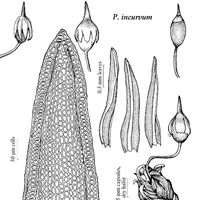Incurved Grizzled Moss
Scientific name: Ptychomitrium incurvum

Cover photo credit: P.M. Eckel
Status
Extirpated
Extirpated
means the species lives somewhere in the world, and at one time lived in the wild in Ontario, but no longer lives in the wild in Ontario.
Date added to the Species at Risk in Ontario List
The Incurved Grizzled Moss was already listed as extirpated when the Endangered Species Act, 2007 took effect in 2008.
Read the most recent assessment report [PDF].
What it looks like
Incurved Grizzled Moss grows in small blackish-green tufts in crevices on dry rocks and on the base of trees in deciduous forests. The leaves, which measure about two millimetres in length, are narrow, concave, and rounded at the hood-shaped apex. They are curled when dry and erect-spreading and somewhat incurved when moist. They are characteristically glossy. The sporophyte (a spore-filled capsule) is erect, reaching up to five millimetres in height.
Where it lives
This small moss grows in eastern deciduous hardwood forests, inhabiting surfaces or tiny crevices of exposed or protected rocks of variable types. It rarely occurs at the base of trees or on logs.
Incurved Grizzled Moss is found in eastern North America and Europe. It is considered relatively common in the eastern and southeastern United States.
Where it’s been found in Ontario
In Canada, the only known location for the species is a single record dated 1828 from a boulder near Niagara Falls in southern Ontario. The species has never been rediscovered here.
Why it disappeared from Ontario
Pollution and habitat destruction may have contributed to the apparent loss of Incurved Grizzled Moss from southern Ontario. However, the causes of its apparent rarity in the early 19th Century and its subsequent disappearance are not well understood.
Action we are taking
Incurved Grizzled Moss receives species protection under the Endangered Species Act, 2007.
All species listed on the Species at Risk in Ontario List may be eligible for consideration for government funding through the Species at Risk Stewardship Program.
What you can do
Report a sighting
Submit your observations of species at risk to the Natural Heritage Information Centre (NHIC), which is Ontario’s conservation data centre. Join the "(NHIC) Rare Species of Ontario" project in iNaturalist to make submitting your observations quick and easy.
Volunteer
Volunteer with species at risk programs, such as community science surveys, through your local nature club, a provincial park or other conservation organizations.
Be a good steward
Private landowners have a very important role to play in species recovery.
If you find species at risk on your land, you may be eligible for stewardship programs that support the protection and recovery of species at risk and their habitats.
Learn more about the Species at Risk Stewardship Program.
Report illegal activity
Report any illegal activity related to species at risk to
Quick facts
- Incurved Grizzled Moss is autoicous, meaning it has both male and female reproductive organs and can self-fertilize.
- The only record of Incurved Grizzled Moss in Ontario is from 1825 near Niagara Falls.
- Incurved Grizzled Moss is still present in the eastern United States. It is commonly found in hardwood forests, on top of or within tiny crevices of rocks, and on the bases of trees or on logs. This suggests Incurved Grizzled Moss is not limited by substrate (what it lives on).